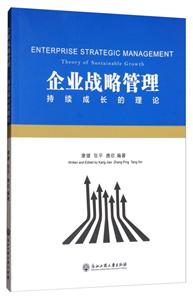包郵 企業(yè)戰(zhàn)略管理:持續(xù)成長的理論:theory of sustainable growth
-
>
以利為利:財(cái)政關(guān)系與地方政府行為
-
>
立足飯碗 藏糧于地——基于中國人均耕地警戒值的耕地保護(hù)視角
-
>
營銷管理
-
>
茶葉里的全球貿(mào)易史(精裝)
-
>
近代華商股票市場制度與實(shí)踐(1872—1937)
-
>
麥肯錫圖表工作法
-
>
海龜交易法則
企業(yè)戰(zhàn)略管理:持續(xù)成長的理論:theory of sustainable growth 版權(quán)信息
- ISBN:9787517823353
- 條形碼:9787517823353 ; 978-7-5178-2335-3
- 裝幀:一般膠版紙
- 冊數(shù):暫無
- 重量:暫無
- 所屬分類:>>
企業(yè)戰(zhàn)略管理:持續(xù)成長的理論:theory of sustainable growth 內(nèi)容簡介
《企業(yè)戰(zhàn)略管理:持續(xù)成長的理論》闡述了企業(yè)戰(zhàn)略管理的基本理論和概念,說明了企業(yè)使命制訂、愿景闡述、內(nèi)外部分析、戰(zhàn)略制訂、戰(zhàn)略執(zhí)行、戰(zhàn)略控制等模塊的內(nèi)容,《企業(yè)戰(zhàn)略管理:持續(xù)成長的理論》主要使用英文進(jìn)行內(nèi)容闡述,重要的關(guān)鍵點(diǎn)和核心概念采用中英文對照的方式進(jìn)行說明。《企業(yè)戰(zhàn)略管理:持續(xù)成長的理論》可以作為管理類本科階段的專業(yè)教材,也可以作為企業(yè)經(jīng)營管理人員、管理咨詢?nèi)藛T以及與企業(yè)戰(zhàn)略管理人員相關(guān)的其他人員學(xué)習(xí)企業(yè)戰(zhàn)略管理分析方法的參考資料。
企業(yè)戰(zhàn)略管理:持續(xù)成長的理論:theory of sustainable growth 目錄
1.1 Strategic Competitiveness
1.2 The Global Economy
1.3 Mission
1.4 Strategic Management Process
1.5 Developing a Strategic Vision and Mission
1.6 Setting Objectives
1.7 Crafting a Strategy
1.8 Implementing and Executing a Strategy
1.9 Approaches to Performing the Strategy-Making Task
1.10 Strategic Management Principle
Chapter 2 External Environment Analysis
2.1 The General, Industry, and Competitor Environments
2.2 External Environmental Analysis
2.3 Scanning
2.4 Industry Environment Analysis
2.5 Threat of New Entrants
2.6 Bargaining Power of Buyers
2.7 Threat of Substitute Products
2.8 Strategic Groups
2.9 Ethical Considerations
2.10 Rivalry Among Competing Sellers
2.11 Control and Environmental Variables
Chapter 3 Internal Environment Analysis
3.1 Analyzing the Internal Organization
3.2 Creating Value
3.3 Resources, Capabilities, and Core Competencies
3.4 Resources
3.5 Tangible Resources
3.6 Intangible Resources
3.7 Capabilities
3.8 Core Competencies
3.9 The Four Criteria of Sustainable Competitive Advantage
3.10 Value Chain Analysis
3.11 Analyzing Driving Forces
Chapter 4 Evaluating Resources and Competitive Capabilities
4.1 A Model of Competitive Rivalry
4.2 Competitor Analysis
4.3 Strategic and Tactical Actions
4.4 Competitive Dynamics
4.5 Company Situation Analysis
4.6 Typical Company Value Chain
Chapter 5 Business-Level Strategies
5.1 Customers: Their Relationship with Business-Level Strategies
5.2 The Purpose of Business-Level Strategies
5.3 Types of Business-Level Strategies
5.4 Cost Leadership Strategies
5.5 Differentiation Strategies
5.6 Focus Strategies
5.7 Focused Cost Leadership Strategies
5.8 Integrated Cost Leadership/Differentiation Strategies
5.9 Levels of Diversification
5.10 Reasons for Diversification
5.11 Value-Creating Diversification. Related Constrained and Related Linked Diversification
Chapter 6 Functional Strategies and Strategic Choices
6.1 Operational Relatedness. Sharing Activities
6.2 Market Power
6.3 Value-Neutral Diversification. Incentives and Resources
6.4 Resources and Diversification
6.5 Value-Reducing Diversification. Managerial Motives to Diversify
6.6 Learning and Developing New Capabilities
6.7 Three Basic Benefits of International Strategies
6.8 International Business-Level Strategies
6.9 Global Strategy
6.10 Acquisitions
6.11 Unbundling and Outsourcing Strategies
6.12 Offensive Strategies and Competitive Advantage
6.13 First-Mover Advantages
6.14 Customer Relationship Management Strategy
Chapter 7 Strategy Implementation
7.1 Implementing Internal Innovations
7.2 Facilitating Integ.ration and Innovation
7.3 Organizational Structure and Controls
7.4 Functional Structure
7.5 The Role of Top-Level Managers
7.6 Top Management Teams
7.7 Managerial Succession
7.8 Sustaining an Effective Organizational Culture
7.9 Establishing Balanced Organizational Controls
7.10 Innovation
7.11 Autonomous Strategic Behavior
7.12 Why the World Economy Is Globalizing
7.13 Internet Strategies for Traditional Businesses
7.14 Tailoring Strategy to Fit Specific Industry Situations
7.15 How Broadly a Company Should Diversify
7.16 Turnaround Strategies
Chapter 8 Strategic Implementation Innovation
8.1 Putting the Innovator's DNA into Practice
8.2 Technology in services
8.3 Services Marketing: Concepts, Strategies
8.4 Meeting Competitive Challenges and Acquiring Critical Resources
8.5 Acquisition Strategy
8.6 Merger, takeover, acquisition
8.7 Vertical Acquisition
8.8 Implementing Internal Innovations
8.9 Cross-Functional Product Development Teams
8.10 The decision-making process
8.11 Information is a Product
Chapter 9 Strategic Evaluation and Control
9.1 Product Diversification as an Example of an Agency Problem
9.2 How Corporate Strategies Form
9.3 Building Core Competencies and Competitive Capabilities
9.4 Key Traits to Building Core Competencies
9.5 Instituting Best Practices and Installing Support Systems
9.6 What Total Quality Management Is
9.7 What Areas Information Systems Should Address
9.8 Guidelines for Designing an Effective Compensation System
9.9 Controlling Process
9.10 Focus on organizational behavior
Chapter 10 Enterprise Growth Strategy
10.1 Entrepreneurial Management
10.2 Related Diversification and Unrelated Diversification Strategies ...
10.3 Strategic entrepreneurship
10.4 Entrepreneurship and Entrepreneurial Opportunities
10.5 Incremental and Radical Innovation
10.6 Autonomous Strategic Behavior
10.7 Design for Six Sigma
10.8 Well-structured problems and programmed decisions
10.9 Risk analysis
10.10 Growth Models with Consumer Optimization
參考文獻(xiàn)
后記
- >
我與地壇
- >
有舍有得是人生
- >
莉莉和章魚
- >
羅曼·羅蘭讀書隨筆-精裝
- >
伊索寓言-世界文學(xué)名著典藏-全譯本
- >
我從未如此眷戀人間
- >
唐代進(jìn)士錄
- >
人文閱讀與收藏·良友文學(xué)叢書:一天的工作
















